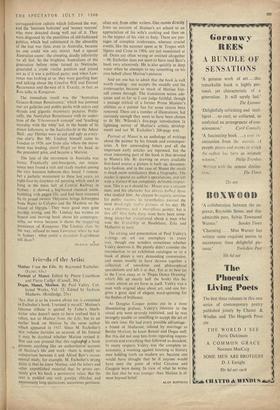Friends of the Artist
Degas, Manet, Morisol. By Paul Valdry. Col- lected Works, Vol 12. Edited by Jackson, Mathews. (Routledge, 25s.) 'ALL that is to be known about me is contained in EsCholier's book. I revised it myself.' Matisse's fulsome tribute is quoted by Faber's blurb- writer who doesn't seem to have realised that it refers, not to Matisse from the Life, but to an earlier book on Matisse by the same author which appeared in 1937. Since M. Escholier's new volume includes an account of his funeral it may be doubted whether Matisse revised it. Nor can one pretend that this ragbag/4f a book presents anything like an authoritative account of Matisse's life and work--there is simply no comparison between it and Alfred Barr's monu- mental study, for example. M. Escholicr's strong point is that he knew Matisse, and the letters and other unpublished material that he prints cer- tainly give his book a permanent value. But the text is padded out with gossipy chitchat and enormously long quotations, sometimes pertinent,
often not, from other writers. One moves directly from an account of Matisse's art school to an appreciation of his wife's cooking and then on to the impact of his visit to Italy. There are pas- sages of complete irrelevance, whereas crucial events, like the summer spent at St. Tropez with Signac and Cross in 1904, are not mentioned at all. Dates are often wrong or omitted altogether —M. Escholier does not seem to have read Barr's book very attentively. He is also quickly in deep water when he attempts to say something on his own behalf about Matisse's pictures.
And yet one has to admit that the book is well worth reading: one accepts the muddle and the irrelevancies because so much of Matisse him- self comes through. The translation seems ade- quate and so far as I can judge faithful, though a passage critical of a former Prime Minister's abilities as a painter has for some reason been removed. There are a number of illustrations, but curiously enough they seem to have been chosen to fit Mr. Wilenski's five-page introduction (a lightning survey of Matisse's artistic develop- ment) and not M. Escholier's 200-page text.
Portrait of Monet is an anthology of writings about the painter by his friends and contempor- aries. A few unrevealing letters and all the important early articles are reprinted, but the most interesting part of the book is that devoted to Manet's life. By drawing on every available first-hand source a picture is built up, documen- tary-fashion, and in the case of Manet the result is much more satisfactory than a biography. The. reader is spared an author's speculations, and left with a distinct if not completely definable impres- sion. This is as it should be: Mallet was a reticent man, and his character has always baffled those who studied him. An elegant bourgeois, anxious for public success, he nevertheless painted the most shockingly realist pictures of his day. He was a charmer, and a marvellous painter, but is this all? One feels. there must have been some- thing altogeller exceptional about a man who won the fr.endihip of Baudelaire, Zola and Mallarrne in turn.
The editing and presentation of Paul Valery's writings on art are exemplary in every way, though one wonders sometimes whether Valdry deserves it. He plainly didn't consider the introduction to an exhibition catalogue or to a book of plates a very demanding commission, and seems usually to have thrown together a collection of anecdotes and philosophical speculations and left it at that. Yet at its best (as in the Corot essay or in 'Degas Dance Drawing' which fills up nearly half the book) this be- comes almost an art form in itself. Valery was a man with original ideas about art, and one for- gives a great deal of elegant word-spinning for the flashes of brilliance.
As Douglas Cooper points out in a most illuminating preface, Valery's interests in the visual arts were severely restricted, and he was strangely unable or unwilling to accept the art of his own time. He had every possible advantage: a friend of Mallarme, related by marriage to Berthe Morisot, he knew Renoir and Degas well. But this did not stop him from regarding impres- sionism and everything that followed as decadent.
In many respects Val6ry was the complete re- actionary, a warning against listening to literary men holding forth on modern art, because one
would have thought that he if anyone would have seen the point of what Cezanne and Gauguin were doing. In view of what he writes the fact that he was younger than Matisse is al- most beyond belief.
ALAN BQWNESS


































 Previous page
Previous page